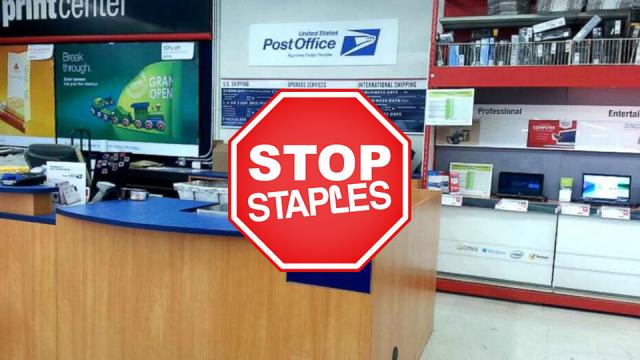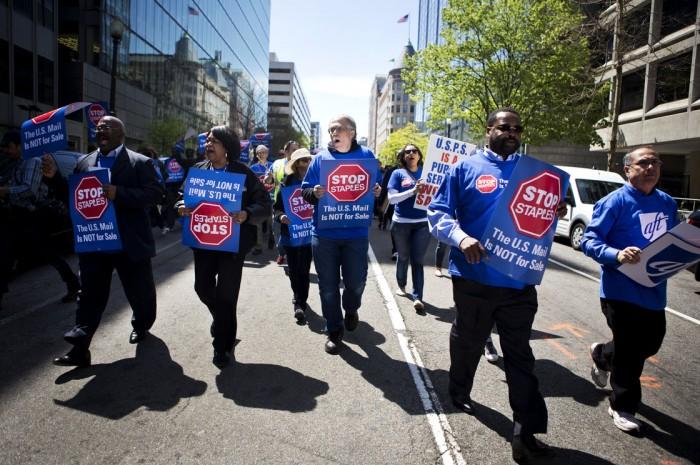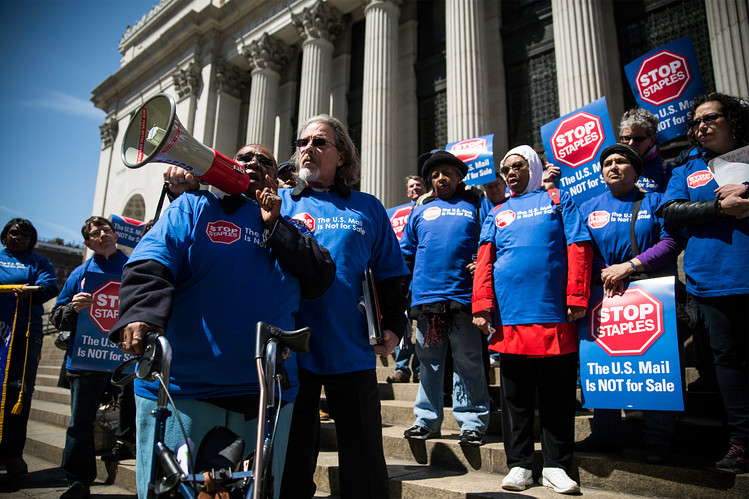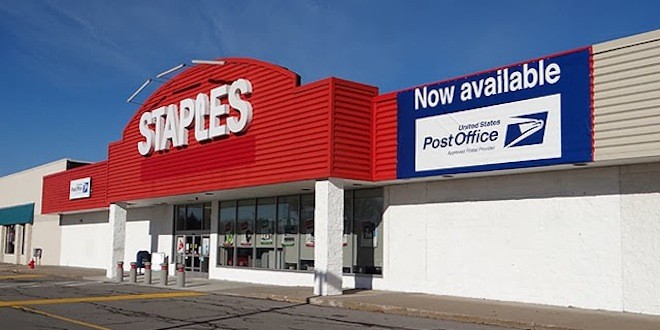
The United States Postal Service (USPS) management just ran into a possible game-changing obstacle to its shameful pursuit of a fully privatized post office: labor solidarity.
Here’s the background. For a decade the USPS has been aggressively shrinking, consolidating, and outsourcing the nation’s postal system. In July 2011 management upped the ante by announcing the rapid closure of 3,600 local post offices, a step toward the eventual closing of as many as 15,000, half of all post offices in the nation.
A groundswell of opposition erupted. Citizens in hundreds of towns mobilized to save a treasured institution that plays a key and sometimes defining role in their communities. In December 2011, after Congress appeared ready to impose a six-month moratorium on closures, USPS management voluntarily adopted a freeze of the same length.
In May 2012, the moratorium ended but management, possibly concerned about reviving a national backlash, embraced an ingenious stealth strategy. Rather than closures, management moved to slash hours at 13,000 post offices.
That could be accomplished quickly. Reduction in hours, unlike outright closures, requires little justification. Appeals are limited. Moreover a reduction in hours doesn’t generate the same level of outrage as a closure. The building remains open even though its value to the community is dramatically diminished.
By the end of this year management may achieve its goal. Already 9,000 post offices have had their hours cut drastically. Part time inexperienced non-career employees have replaced full time experienced career postmasters. Management duly held meetings in every affected community but refused to heed or even respond to the counsel of local residents and businesses or provide them the data used to justify its decision.
Postal clerks and letter carriers are the personal face of the most ubiquitous, trusted and respected of all public institutions. By gradually replacing to-the-door service with delivery to more remote cluster mailboxes management has already reduced our personal interaction with letter carriers.
Last fall USPS management proceeded with the second phase in its campaign to sever our personal links to the postal clerks by quietly launching a pilot project in 82 Staples stores. After the news became public, management ingenuously announced that nothing had changed.
“Staples joins with more than 65,000 retailers... who currently provide expanded access to postal products and services.” Management conveniently forgot to mention that these 65,000 locations just sell stamps or flat boxes. None hosts a postal counter staffed by a retail employee that sells services.
The arrangement with Staples is different. As management conceded, Staples “is the first retailer to take part in a USPS pilot program dubbed the Retail Partner Expansion Program.” The Retail Partner Expansion Program creates mini post offices inside big box stores.
If the pilot proves successful the USPS expects to expand it to all 1,500 Staples. And then to all big box retail outlets. Steve Hutkins, creator of the inestimable SaveOurPostOffice.org runs the numbers. We can now buy stamps at 7,450 Walgreens; 3,830 Wal-Marts; 1,632 Staples; 1,200 Office Depots; 847 Safeways; 609 Sam’s Clubs; and 426 Costcos. That adds up to over 14,000 locations.
“If all of those arrangements were converted from selling stamps on consignment to setting up postal counters, the Postal Service would have an instant infrastructure of 'mini post offices' to replace real post offices…”
A bill introduced by Rep. Darrell’s Issa (R-CA) would make this replacement much easier. According to Section 103 of the Postal Reform Act of 2013 the right to appeal a post office closing to the Postal Regulatory Commission “shall not apply to a determination of the Postal Service to close a post office if there is located, within 2 miles of such post office, a qualified contract postal unit.” There are 1,200 post offices within two miles of just the Staples retail network.
For management, replacing a real post office with a fake post office is a good deal. USPS average pay is about $25 an hour. Staples retail clerks earn about $8.50 an hour.
For the customer this is a bad deal. Staples’ employees receive just four hours of “classroom” training for postal retail duties. Postal retail clerks receive 32 hours of intense classroom training, followed by 40 hours of on-the-job training alongside experienced window clerks.
Postal workers must pass a test before they are considered qualified to work the window. Given the turnover at Staples it’s unlikely the employee at the postal counter is going to be around long enough to acquire the experience or expertise of a career postal worker.
For the community this is an awful deal. A cherished local institution created to serve the public interest would be replaced by a counter in a business created to serve distant shareholders and management. If its economic self-interest dictated, Staples could decide to close the store.
To underline the reality of this threat, in March Staples announced it will shutter up to 225 stores. That would leave the community without any postal services at all.

Labor Solidarity to the Rescue
The American Postal Workers Union (APWU) responded to management’s hostile action by organizing protests around the country. On April 24, a Day of Action resulted in hundreds of pickets, marches and rallies in more than 50 cities across 27 states under the rallying cry, “Stop Staples: The U.S. Mail is Not for Sale."
In late May, Staples Vice Chairman Joe Doody nervously acknowledged the USPS deal “could become a problem if more unions backed the postal workers.” He told the Boston Globe, “The retailer will continue to evaluate the situation to determine whether the negative backlash is worth the benefits of the partnership.”
Staples had signed the deal because it was desperate to gain more traffic through its stores. If the deal actually reduces traffic and sales, Staples would reconsider.
State labor unions and national federations began to endorse the "Don’t Buy Staples" campaign. On May 30, the AFL-CIO, comprised of 56 unions representing 12.5 million members, came out in support of the boycott. In mid June, California’s Service Employees International Union 32BJ, representing 145,000 union members in 11 states and the District of Columbia, voted for a boycott.
In a letter to the Staples CEO, SEUI 32BJ President Héctor Figueroa observed, “The Postal Service is the largest single civilian employer of union middle-class jobs for African Americans, and Veterans (including disabled veterans), and is the largest single civilian union employer. We need more of these types of jobs to strengthen our economy and the middle class, and we will not accept your efforts to undermine them through low-wage privation.”
After July 4, more unions formally joined the boycott. Perhaps they were inspired by Benjamin Franklin’s enduring comment at the signing of the Declaration of Independence, “We must all hang together or assuredly we shall all hang separately.”
In July, the International Association of Firefighters representing more than 300,000 backed the boycott. AFSCME union, representing 1.6 million public-sector workers, followed suit. Then on July 12, the 1.5 million member American Federation of Teachers (AFT) delivered the coup de grace when it signed on.
APWU President Mark Dimondstein made the case for solidarity to the convention, “We too are in the public sector, we too are meeting the needs of people. We’re facing some of the same problems you are—I call it divert, defund, demoralize, demonize and dismantle.”
American Federation of Teachers President Randi Weingarten responded, “Who does Staples really want and need to come into its stores every single day? Teachers. The best way we can help is if we say to Staples: ‘You do this to the postal workers, and we aren’t buying supplies in your stores.’”
School supplies are a key market for Staples, accounting for up to one-third of its sales. Last year teachers spent about $1.6 billion of their own money on school supplies. Back-to-school supply-buying gets going in earnest in late July.
On July 14, Staples announced it had withdrawn from the Retail Partner Expansion Program.
The celebrations have been muted. Postal service management hasn’t thrown in the towel. It’s simply changed the name of the program. As one USPS spokesperson explained, "We look forward to continuing the partnership whether it’s called Retail Partner Expansion or approved shipper."
The USPS wants to establish a beachhead in thousands of retail stores. Once a postal counter staffed by low paid non union non postal service employees begins to sell services it will be easy to expand the kinds of services it offers.
But the Staples announcement and USPS’s obfuscation demonstrates that retail stores are vulnerable to boycotts, especially those organized by people in the communities they serve. Teachers, firefighters, government workers, service employees live in significant numbers in every community. They can form the backbone of an effort that puts big box retailers and USPS management on notice. Hands off our post office!
And who knows? Hands off our post office could evolve into Give us back our post office! A successful boycott to stop the further privatization of the post office could then move demand that the post office be restored to its former glory and effectiveness by reopening processing centers, extending local post office hours and rehiring experienced staff. Benjamin Franklin, the first Postmaster General of the United States, would be pleased.
3 WAYS TO SHOW YOUR SUPPORT
- Log in to post comments













